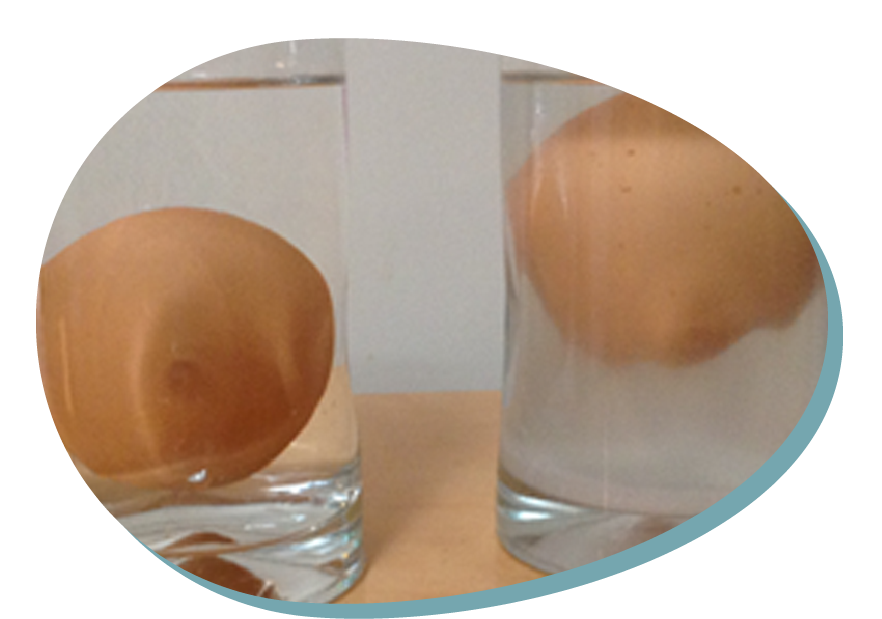Egg and salt floating experiment
Type of resource: Web page
Web address https://igamemom.com/free-app-interactive-educational-toy-ubooly/
Language: English
Description
Experiment with eggs, water and salt to see how salt affects the density of the water and therefore the floatability of the eggs.
Scientific concept introduced
Liquid density, buoyancy, floatability.
Creative and critical thinking
To imagine other ways of mesuring the density of liquids.
Mathematical reasoning
To be precise in the amount of salt they are using.
To develop the ability to observe and discover.
Scientific thinking
To ask questions.
To analyze and solve problems (floating).
To conduct a research (create an hypothesis about what will happen with the different amounts of salt in the water).
Learning how to learn
Feeling of self-efficacy in learning, since it is an experiment they could do on their own.
To develop their motivation to learn and engage with the activities.
Additional
Use of hand-eye coordination
Sharing ideas with other classmates
Learning science vocabulary
Egg and salt floating experiment
Overall aims
To develop the ability to observe and discover
To strengthen the research attitude of children
To improve children’s problem-solving (take initiative)
To create the learning opportunity for explaining the concepts of density and bouyancy
Vocabulary – keywords should be understood
Basic vocabulary: density and buoyancy
Other vocabulary: transparency
Expected learning outcomes (operational aims)
To run the experiment
To do a observation over time
To explain the concept of density and buoyancy
To deduce the relationship between density and buoyancy
STEM skills – to which the learning unit is related to
CORE STEM SKILLS
● Asking questions.
● Analysing and solving problems.
● Designing experiments.
● Drawing conclusions based on results.
● Motivation to learn and engage.
● Self-discipline and self-regulated learning (cognitive autonomy).
ADDITIONAL SKILLS
● Sharing ideas
● Hand-eye coordination
● Taking common decisions
● Creativity: design other buoyancy experiments
Teaching methodologies/activity outline
1- Ask questions about personal experiencies about buoyancy. For exemple: Is the same when you swimming in the sea or swimming in the pool? Where you float the most?
2- Give them time to experiment with the egs and the salt.
3- If you can do the experiments with two or free eggs and glass, you can observed the disparity between the buoyancy depending to the amount of salt.
4- Draw conclusions about the more or less salt in the wather (density) has an impact in the buoyancy.
Assessment of learning
Initial evaluation
– Get to know the previous knowledge they could know about the same theme.
Continued evaluation
– Progressively acquire basic habits of autonomy in everyday actions, to act safely and effectively.
– Think, create and start to know basic scientific concepts (density and buoyancy)
– Observe and explore the immediate, natural and physical environment, with an attitude of curiosity and respect and gradually participate in social and cultural activities.
– Progressively acquire basic habits of autonomy in the experiment.
– Use the oral language and gesture to express ideas, desires, feelings and emotions;
– Use the oral language to explain, discuss, support a point of view
– Listen and participate actively in regular situations. Conversation and learning with the use of non-discriminatory language, and with attitude of respect towards other cultures and different languages.
– Creativite in other similar experiments about buoyancy.
Final evaluation
– To evaluate the learning objectives, use the chart in which the more important
elements will be highlighted.
Equipment and materials to be used in learning unit (tools, ingredients etc)
● A raw egg or more.
● A glass that you can see through. A glass or more if you want to do a comparative experiment.
● Water.
● Salt, just regular salt you use for cooking.
● A spoon.
Kind of setting
Lab, kitchen or Preschool room
References – source
https://igamemom.com/free-app-interactive-educational-toy-ubooly/
Egg and salt floating experiment
1. Usefulness for STEM education – integrating content of different disciplines
Cross-curricular character of the resource

The range of S-T-E-M subjects included

The presentation of possibilities of including artistic activities (STEAM approach)

2. Expected learning outcomes
Consistency (links) with preschool core curriculum

Communicativeness of description

3. Methodology of teaching
Clarity, communicativeness of instructions for teachers

Meaningful learning – using practical life problems

Original idea

The level of ease in implementing the methodology to preschool age children

The level of ease in preparing necessary ingredients, materials and equipment needed

4. Sustainability
Ecological characteristics of materials/ results

Supporting healthy eating habits

Low ecological footprint

Possibilities of inclusion (respecting cultural diversity and food intolerances)

5. Class management
Using differentiated forms of work – individual, team work etc.

Individual work

Team work

Whole group
6. Time management

Short activity (10-15 minutes)

Medium activity (20-30 minutes)

Long activity (1 hour or more)

Very long activity (1 day or more)
PDF: https://www.printfriendly.com/p/g/GCApL6

